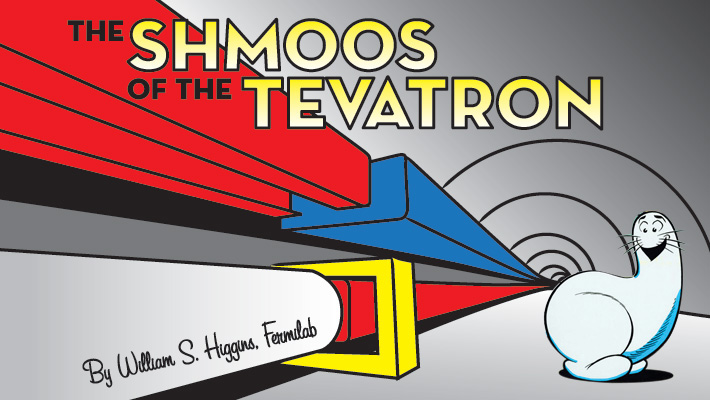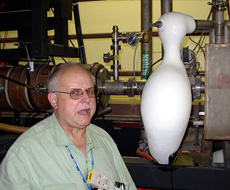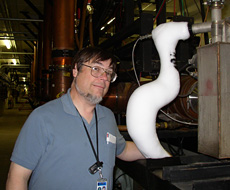
Signal to background
Shmoos of the Tevatron
Particles like the top quark weren’t the only characters to appear at Fermilab’s Tevatron. A physicist waxes nostalgic as scientists prepare to celebrate the accelerator’s contributions to science, technology and society at a symposium this month.
By William S. Higgins, Fermilab


Now that the Tevatron has shut down, I’m going to miss the Shmoos.
America first learned of the Shmoos in the funny papers. In 1948, Al Capp’s comic strip Lil’ Abner featured a sequence where Abner stumbled upon the Valley of the Shmoon. There he encountered the Shmoos, lovable creatures whose only goal in life was to please people. They were edible, all their parts were useful, and they bred so fast that there was always a plentiful supply of new Shmoos.
To quote Lil’ Abner himself, speaking in his distinctive accent, “Shmoos does EVERYTHING! They gives milk, aigs, meat, an’ th’ eyes makes fine suspender buttons!!”

But introducing Shmoos to the town of Dogpatch, and then to the entire United States, rapidly turned into a disaster: “Nobody whut’s got Shmoos HAS t’work any morean’ ANYBODY kin have ‘emfo’ FREE!!” With everyone’s needs provided, the national economy ground to a halt. Only when the Shmoos were eliminated did life go back to normal.
Readers of the comics may or may not have appreciated Capp’s parable of economics. But they certainly loved the Shmoos. There was a craze for Shmoo books, Shmoo toys and Shmoo salt-shakers. I loved them as much as everyone else did.
Lil’ Abner ended when Al Capp passed away. I grew up. I got a job working on a very big particle accelerator, the Fermilab Tevatron. And one day, I found the Shmoos again.
The Tevatron faithfully accelerated protons and antiprotons from 1983 until it shut down several months ago. Throughout its 28 years of operation, the Tevatron’s superconducting magnets had to be kept very cold, at temperatures just a few degrees above absolute zero. Necessarily, there were a few places within the 6-kilometer-long tunnel where cold equipment met warm equipment.

Now and then, when the beams were off, my work with Accelerator Division Radiation Safety would take me into the tunnel, often with my buddy Roger Zimmermann. Roger and I would walk through the F-Zero region, where beam pipes injected particles into the Tevatron. There we would find a pair of nitrogen shield vents that were very cold.
Cold enough to condense moisture from the surrounding air. Cold enough for the moisture to freeze. Cold enough, for long enough, that layers of smooth white ice would build up into a gently curved shape.
A Shmoo.
Younger accelerator workers might see this buildup and call it an “iceball.” Roger and I were old enough to remember Lil’ Abner. So we knew the truth: Driven out of Dogpatch, Capp’s cuddly creatures had found a home beneath the Illinois prairie. It was like greeting an old friend.
When the Tevatron closed for good, the equipment in the tunnel gradually warmed to room temperature. The icy white Shmoos began to sublimate, or melt, or evaporate, and literally vanish into the air. They have returned to the realm of imagination, which is, after all, where Shmoos began.
Editor’s note: The Tevatron symposium, which celebrated the Tevatron’s many achievements and the future of Fermilab, took place on June 11, 2012. Speakers included Harvard University Professor Lisa Randall, CERN Director-General Rolf Heuer, UK Science and Technology Facilities Council CEO John Womersley, Fermilab Director Pier Oddone and a number of notable figures from the Tevatron's history.






